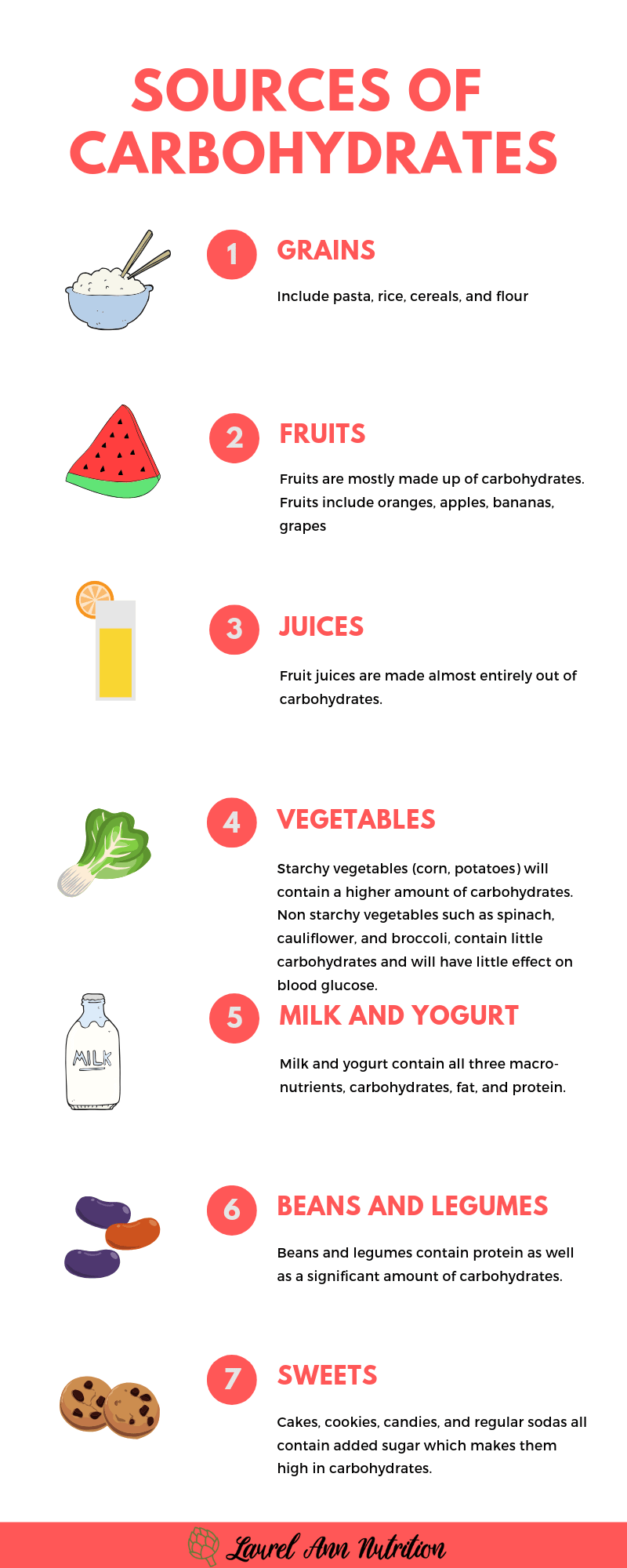Consistent Carbohydrate Diet: What is it and is it right for me?
The consistent carbohydrate diet provides flexibility in what you can eat and which sources of carbohydrates you want to include. The focus of the Consistent Carbohydrate Diet is to keep a level amount of carbohydrates throughout each meal that is the same from one day to the next (1).
First, let’s cover some of the basics before we dive into the diet.
Brand new to diabetes? Check out the Diabetes 101 post to get up to date on the lingo :-)
ARe there good carbs for people with diabetes?
Yes! Carbohydrates (carb for short) are an essential part of our diet. Carbohydrates are one of three marcro-nutrients, the other two being protein and fat. Carbohydrates break down into glucose in the body and there are 4 calories per gram.
Glucose helps fuel our body with energy. Finding the right amount of carbohydrates for yourself may be complex. We will all have a different amount of carbohydrates that our bodies will need based on our height, weight, age, activity levels, medications, and medical history. Talk with your dietitian about what is the appropriate amount of carbohydrates for you.
What are sources of carbohydrates?
Carbohydrates have the largest effect on our blood glucose so it is important to know where they are found in our diet.
Is fiber a carbohydrate?
Yes, you guessed it! There are three different types of carbohydrates: sugars, starch, and fiber. Fiber is a carbohydrate that leaves the stomach mostly undigested.
Fiber helps slow down the digestion of sugars and help prevent high blood glucose jumps. For example, juice contains very little fiber and therefore causes blood glucose to spike easily.
Other benefits of fiber include: feeding friendly bacteria in the colon, regulating bowels, and decreasing cholesterol (2).
Sources of fiber: vegetables, fruit, whole grains, nuts, and seeds.
Complex Carbohydrates vs Simple Carbohydrates
The other two types of carbohydrates include sugars, aka our simple carbs, and starch, our complex carbohydrates. Both simple and complex carbohydrates eventually break down into glucose in the body.
Sugars are called simple carbohydrates because they are easily broken down into glucose in our bodies. Sugars cause the highest jumps in blood glucose. In our diet, we can find natural sugars in fruit and vegetables and added sugars in sodas and baked goods.
Starch is called a complex carbohydrate because it contains complex “bonds” that take longer to break down into glucose in our bodies. Starches will cause a slower increase in our blood glucose compared to simple sugars. In our diet, we can find starches in potatoes, rice, wheat, and corn.
Many foods such a fruit and vegetables can contain all three different types of carbohydrates.
What does Low-Glycemic mean?
Low-glyWHAT? The glycemic index measures how a carbohydrate-containing food raises our blood glucose (3).
A low-glycemic food raises our blood glucose less than a high-glycemic food (3). Low-glycemic foods include non-starchy vegetables while high-glycemic foods include white bread.
Fat and fiber tend to make a food a low-glycemic food (3).
Does it matter which type of carbohydrate I eat?
Evidence shows that it is MOST important to focus on the amount of carbohydrates in our diet over the type of carbohydrate (4). The number of carbohydrates affects our blood glucose more than the type of carbohydrates we consume (4).
With that said, studies show that low-glycemic, high fibers foods are beneficial to our health and glucose control (5, 6, 7).
It is important to note that there are healthy foods on either end of the glycemic index. Using the glycemic index is meant as a guide and should be balanced with other basic nutrition concepts.
Do fat and protein increase my blood glucose?
The simple answer is no.
Studies show ingesting protein does not increase blood glucose concentrations in persons with controlled type 2 diabetes (4).
In uncontrolled individual or insulin-dependent individuals, studies show that protein may create a slight increase in blood glucose levels (8, 9, 10).
At the end of the day, it is best to check your blood glucose meter before and after a meal to see how you respond.
The addition of fat to a carbohydrate food has actually shown to decrease the blood glucose spike (11, 12). Addition of healthy fats to the diet can be beneficial and should be used as part of a balanced diet. Excess fat intake may be linked to increased insulin resistance (9). Balance is KEY!
Consistent Carbohydrate Counting
The focus of the Consistent Carbohydrate Diet is to keep a level amount of carbohydrates throughout each meal that is the same from one day to the next.
The diet is not much different than a regular healthy diet, you just need to regulate the amount of carbohydrates you have with each meal and snack.
The consistent carbohydrate does take carbohydrate counting skills but over time these skills become second nature. Carbohydrates are broken down into 15 gram portions. Your dietitian can help you decided how many carbohydrate choices are appropriate for you.
Goals of the Consistent Carbohydrate Diet:
Avoid erratic blood glucose patterns- studies show that having a consistent pattern of blood glucose can help improve quality of life and reduce chances of contracting other conditions:
Increase the level of enjoyment of meals by increasing food choices
Love pasta, rice, and potatoes but feel they are a “no no” for people with diabetes? With the consistent carbohydrate diet, you can include these foods previously deemed “forbidden,” as long as they fit into your consistent carbohydrate amount.
Improve your A1c
Tips for starting a Consistent Carbohydrate diet:
First, talk with your doctor and dietitian to see if this is the right diet for you.
A dietitian can help you decide the right amount of carbohydrates for you and your lifestyle.
Your meter is your best friend!
When trying out a new carbohydrate or meal make sure to check your blood glucose before you eat and 1 to 2 hours after you eat.
Everyone reacts differently to different foods. Keep a written record of the foods you like and tolerate the most.
You are tolerating a carbohydrate well if your blood glucose does not spike over 180 two hours after eating according to the American Diabetes Association. You may want to have a lower goal than 180 if you are not meeting your A1c target (16, 17).
Plan ahead!
Once you know your carbohydrate count, plan your meals ahead of time to help you stick to it.
Practice carbohydrate counting and check labels!
Get to know the carbohydrate count of your favorite foods and keep a list in your wallet or on your fridge.
Carbohydrate counting is easier when there is a nutrition label available. Check nutrition labels and portion sizes to determine the carbohydrate count.
The intent of this article is to provide information about the consistent carbohydrate diet. It may work great for you! Or it may not be the best fit. ALWAYS talk with your doctor and dietitian before making drastic changes to your diet.
Looking for individualized recommendations? Schedule a free consultation today!
Want some delicious diabetic friendly recipes? Look no further :-)
Author: Laurel Ann Deininger, MS, RDN, LDN, CDE


































This article is here to help make eating and managing your blood sugar easier during pregnancy! You will learn why snacking is important, why carbs are important during pregnancy, how to enjoy carbs without spiking the blood sugar, and a LONG list of snack ideas.